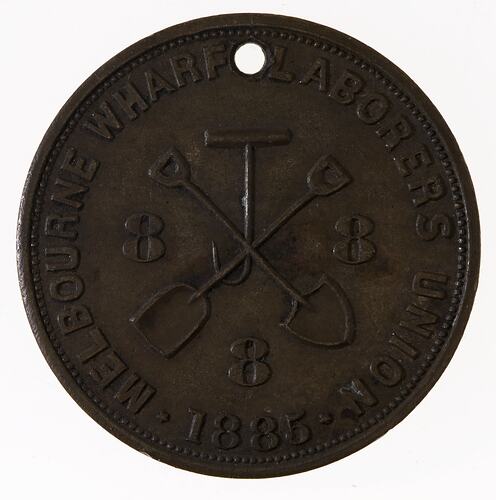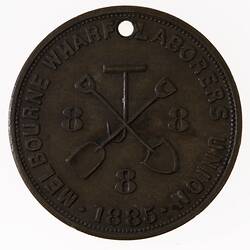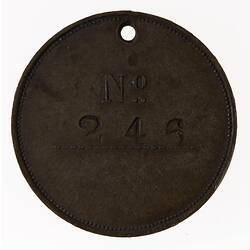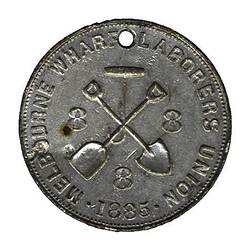Summary
Medal issued in the same year that the Melbourne Wharf Laborers' Union was formed. In 1885 ship owners outraged waterside workers by refusing to let them attend the Eight Hour Day anniversary march. Trades Hall representatives stepped in and the Melbourne Wharf Laborers' Union was formed.
Action taken by stonemasons on 21 April 1856 led to the establishment of the Eight Hour Day, with the government agreeing that workers employed on public works should enjoy an eight hour day with no loss of pay. It was a world first and became emblematic of the rights of labour. In recognition of the significance of this achievement, April 21 was made a public holiday in 1879 and commemorative marches were held each year from 1879 until 1951. The Eight Hour Day holiday was renamed Labour Day in 1934. In 1955 the Labour Day march and celebrations were replaced by Moomba celebrations.
Physical Description
A copper medal (27 mm diameter) featuring the 888 of the eight hour movement and wharf labourer's tools, a spade an shovel and a bale hook.
Obverse Description
At centre crossed spade, shovel and bale hook; in angles, 8 8 8 ; around, .MELBOURNE WHARF LABORERS UNION . 1885
Reverse Description
No. / ------------ stamped 246 above dotted line
Edge Description
Plain
Significance
In the early 1880s waterside workers on the Yarra River wharves near central Melbourne held local strikes, but were not unionised. In 1884 the workers staged their first total walkout over hours, pay and hiring practices, but were disadvantaged by lack of formal organization and solidarity from other unions. Then, in 1885, ship owners outraged the workers by refusing to let them attend the Eight Hours' anniversary march. Trades Hall representatives stepped in, and the Melbourne Wharf Laborers' Union was formed. -Australian National University web site http://www.anu.edu.au/polsci/marx/interventions/aftergold.htm. -D. Tout-Smith 26/9/2003.
More Information
-
Collecting Areas
-
Acquisition Information
Transfer from National Gallery of Victoria (NGV), 15 Mar 1976
-
Date Issued
1885 AD
-
Issued By
Melbourne Wharf Laborers' Union, Melbourne, Greater Melbourne, Victoria, Australia, 1885
-
Inscriptions
Obverse: 8 8 8 MELBOURNE WHARF LABORERS UNION 1885 Reverse: No. / ------------ stamped 246 above dotted line
-
Series
-
Material
Bronze
-
Axis
12
-
Classification
-
Category
-
Discipline
-
Type of item
-
Dimensions
27 mm (Outside Diameter), 10.63 g (Weight)
-
Shape
Round
-
Keywords
8 Hours Day Movement, Trade Unions, Workers Rights, Workers, Working Life, Making History - Eight Hour Day



